Yihua Cheng
Excavate the potential of Single-Scale Features: A Decomposition Network for Water-Related Optical Image Enhancement
Aug 06, 2025Abstract:Underwater image enhancement (UIE) techniques aim to improve visual quality of images captured in aquatic environments by addressing degradation issues caused by light absorption and scattering effects, including color distortion, blurring, and low contrast. Current mainstream solutions predominantly employ multi-scale feature extraction (MSFE) mechanisms to enhance reconstruction quality through multi-resolution feature fusion. However, our extensive experiments demonstrate that high-quality image reconstruction does not necessarily rely on multi-scale feature fusion. Contrary to popular belief, our experiments show that single-scale feature extraction alone can match or surpass the performance of multi-scale methods, significantly reducing complexity. To comprehensively explore single-scale feature potential in underwater enhancement, we propose an innovative Single-Scale Decomposition Network (SSD-Net). This architecture introduces an asymmetrical decomposition mechanism that disentangles input image into clean layer along with degradation layer. The former contains scene-intrinsic information and the latter encodes medium-induced interference. It uniquely combines CNN's local feature extraction capabilities with Transformer's global modeling strengths through two core modules: 1) Parallel Feature Decomposition Block (PFDB), implementing dual-branch feature space decoupling via efficient attention operations and adaptive sparse transformer; 2) Bidirectional Feature Communication Block (BFCB), enabling cross-layer residual interactions for complementary feature mining and fusion. This synergistic design preserves feature decomposition independence while establishing dynamic cross-layer information pathways, effectively enhancing degradation decoupling capacity.
Learning Velocity and Acceleration: Self-Supervised Motion Consistency for Pedestrian Trajectory Prediction
Mar 31, 2025Abstract:Understanding human motion is crucial for accurate pedestrian trajectory prediction. Conventional methods typically rely on supervised learning, where ground-truth labels are directly optimized against predicted trajectories. This amplifies the limitations caused by long-tailed data distributions, making it difficult for the model to capture abnormal behaviors. In this work, we propose a self-supervised pedestrian trajectory prediction framework that explicitly models position, velocity, and acceleration. We leverage velocity and acceleration information to enhance position prediction through feature injection and a self-supervised motion consistency mechanism. Our model hierarchically injects velocity features into the position stream. Acceleration features are injected into the velocity stream. This enables the model to predict position, velocity, and acceleration jointly. From the predicted position, we compute corresponding pseudo velocity and acceleration, allowing the model to learn from data-generated pseudo labels and thus achieve self-supervised learning. We further design a motion consistency evaluation strategy grounded in physical principles; it selects the most reasonable predicted motion trend by comparing it with historical dynamics and uses this trend to guide and constrain trajectory generation. We conduct experiments on the ETH-UCY and Stanford Drone datasets, demonstrating that our method achieves state-of-the-art performance on both datasets.
Trajectory Mamba: Efficient Attention-Mamba Forecasting Model Based on Selective SSM
Mar 13, 2025Abstract:Motion prediction is crucial for autonomous driving, as it enables accurate forecasting of future vehicle trajectories based on historical inputs. This paper introduces Trajectory Mamba, a novel efficient trajectory prediction framework based on the selective state-space model (SSM). Conventional attention-based models face the challenge of computational costs that grow quadratically with the number of targets, hindering their application in highly dynamic environments. In response, we leverage the SSM to redesign the self-attention mechanism in the encoder-decoder architecture, thereby achieving linear time complexity. To address the potential reduction in prediction accuracy resulting from modifications to the attention mechanism, we propose a joint polyline encoding strategy to better capture the associations between static and dynamic contexts, ultimately enhancing prediction accuracy. Additionally, to balance prediction accuracy and inference speed, we adopted the decoder that differs entirely from the encoder. Through cross-state space attention, all target agents share the scene context, allowing the SSM to interact with the shared scene representation during decoding, thus inferring different trajectories over the next prediction steps. Our model achieves state-of-the-art results in terms of inference speed and parameter efficiency on both the Argoverse 1 and Argoverse 2 datasets. It demonstrates a four-fold reduction in FLOPs compared to existing methods and reduces parameter count by over 40% while surpassing the performance of the vast majority of previous methods. These findings validate the effectiveness of Trajectory Mamba in trajectory prediction tasks.
PersonaBooth: Personalized Text-to-Motion Generation
Mar 10, 2025Abstract:This paper introduces Motion Personalization, a new task that generates personalized motions aligned with text descriptions using several basic motions containing Persona. To support this novel task, we introduce a new large-scale motion dataset called PerMo (PersonaMotion), which captures the unique personas of multiple actors. We also propose a multi-modal finetuning method of a pretrained motion diffusion model called PersonaBooth. PersonaBooth addresses two main challenges: i) A significant distribution gap between the persona-focused PerMo dataset and the pretraining datasets, which lack persona-specific data, and ii) the difficulty of capturing a consistent persona from the motions vary in content (action type). To tackle the dataset distribution gap, we introduce a persona token to accept new persona features and perform multi-modal adaptation for both text and visuals during finetuning. To capture a consistent persona, we incorporate a contrastive learning technique to enhance intra-cohesion among samples with the same persona. Furthermore, we introduce a context-aware fusion mechanism to maximize the integration of persona cues from multiple input motions. PersonaBooth outperforms state-of-the-art motion style transfer methods, establishing a new benchmark for motion personalization.
3D Prior is All You Need: Cross-Task Few-shot 2D Gaze Estimation
Feb 06, 2025Abstract:3D and 2D gaze estimation share the fundamental objective of capturing eye movements but are traditionally treated as two distinct research domains. In this paper, we introduce a novel cross-task few-shot 2D gaze estimation approach, aiming to adapt a pre-trained 3D gaze estimation network for 2D gaze prediction on unseen devices using only a few training images. This task is highly challenging due to the domain gap between 3D and 2D gaze, unknown screen poses, and limited training data. To address these challenges, we propose a novel framework that bridges the gap between 3D and 2D gaze. Our framework contains a physics-based differentiable projection module with learnable parameters to model screen poses and project 3D gaze into 2D gaze. The framework is fully differentiable and can integrate into existing 3D gaze networks without modifying their original architecture. Additionally, we introduce a dynamic pseudo-labelling strategy for flipped images, which is particularly challenging for 2D labels due to unknown screen poses. To overcome this, we reverse the projection process by converting 2D labels to 3D space, where flipping is performed. Notably, this 3D space is not aligned with the camera coordinate system, so we learn a dynamic transformation matrix to compensate for this misalignment. We evaluate our method on MPIIGaze, EVE, and GazeCapture datasets, collected respectively on laptops, desktop computers, and mobile devices. The superior performance highlights the effectiveness of our approach, and demonstrates its strong potential for real-world applications.
Efficient Driving Behavior Narration and Reasoning on Edge Device Using Large Language Models
Sep 30, 2024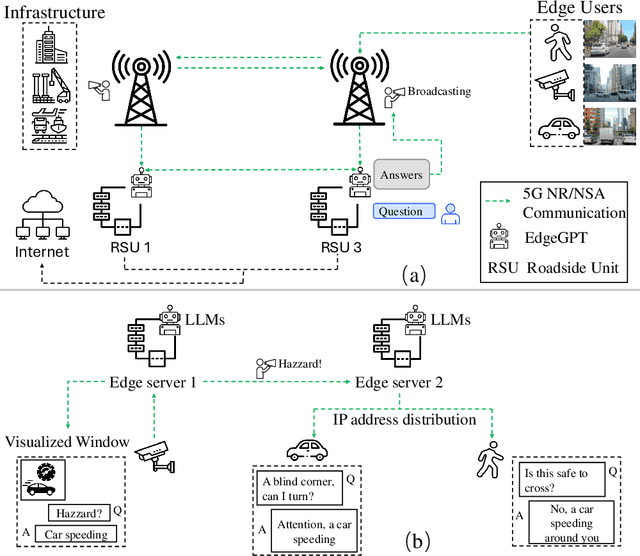
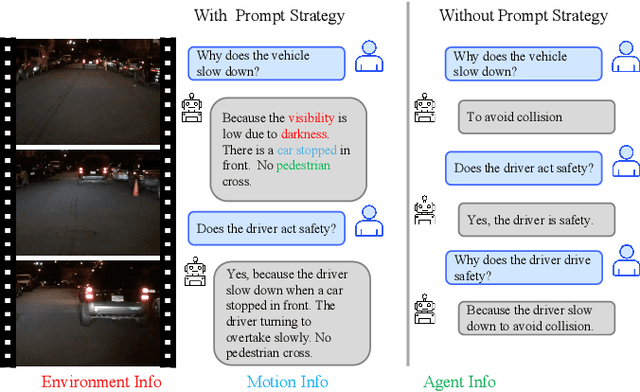


Abstract:Deep learning architectures with powerful reasoning capabilities have driven significant advancements in autonomous driving technology. Large language models (LLMs) applied in this field can describe driving scenes and behaviors with a level of accuracy similar to human perception, particularly in visual tasks. Meanwhile, the rapid development of edge computing, with its advantage of proximity to data sources, has made edge devices increasingly important in autonomous driving. Edge devices process data locally, reducing transmission delays and bandwidth usage, and achieving faster response times. In this work, we propose a driving behavior narration and reasoning framework that applies LLMs to edge devices. The framework consists of multiple roadside units, with LLMs deployed on each unit. These roadside units collect road data and communicate via 5G NSR/NR networks. Our experiments show that LLMs deployed on edge devices can achieve satisfactory response speeds. Additionally, we propose a prompt strategy to enhance the narration and reasoning performance of the system. This strategy integrates multi-modal information, including environmental, agent, and motion data. Experiments conducted on the OpenDV-Youtube dataset demonstrate that our approach significantly improves performance across both tasks.
NL2Contact: Natural Language Guided 3D Hand-Object Contact Modeling with Diffusion Model
Jul 17, 2024Abstract:Modeling the physical contacts between the hand and object is standard for refining inaccurate hand poses and generating novel human grasp in 3D hand-object reconstruction. However, existing methods rely on geometric constraints that cannot be specified or controlled. This paper introduces a novel task of controllable 3D hand-object contact modeling with natural language descriptions. Challenges include i) the complexity of cross-modal modeling from language to contact, and ii) a lack of descriptive text for contact patterns. To address these issues, we propose NL2Contact, a model that generates controllable contacts by leveraging staged diffusion models. Given a language description of the hand and contact, NL2Contact generates realistic and faithful 3D hand-object contacts. To train the model, we build \textit{ContactDescribe}, the first dataset with hand-centered contact descriptions. It contains multi-level and diverse descriptions generated by large language models based on carefully designed prompts (e.g., grasp action, grasp type, contact location, free finger status). We show applications of our model to grasp pose optimization and novel human grasp generation, both based on a textual contact description.
CacheBlend: Fast Large Language Model Serving with Cached Knowledge Fusion
May 26, 2024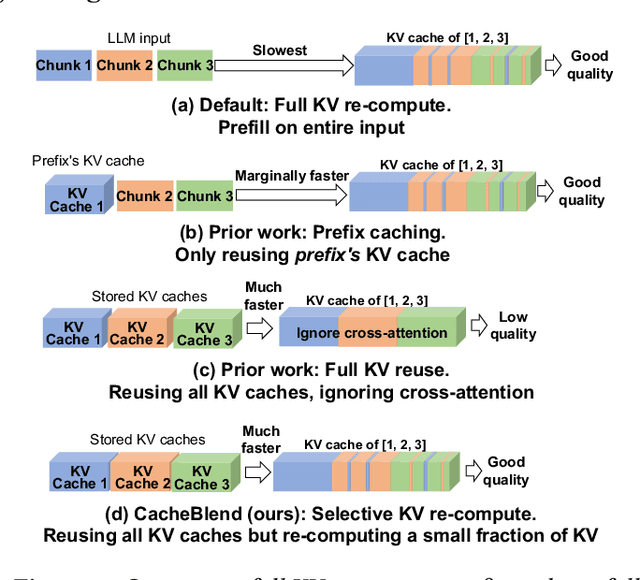
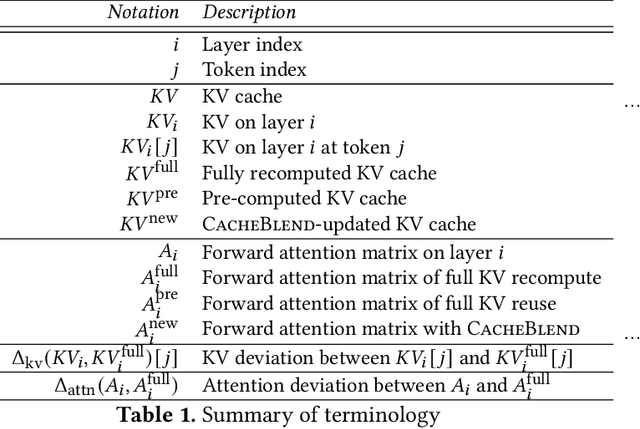
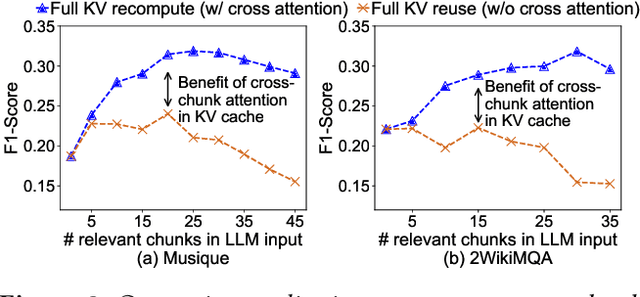
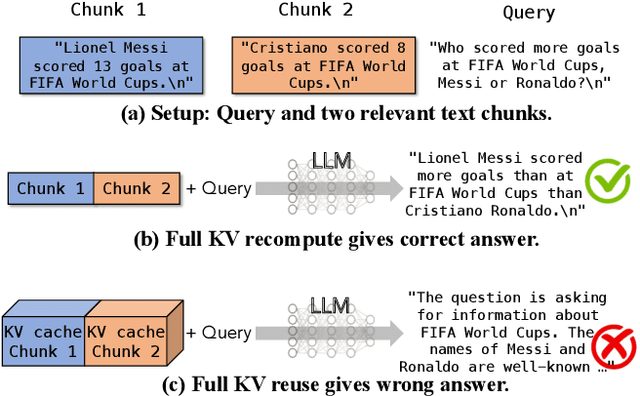
Abstract:Large language models (LLMs) often incorporate multiple text chunks in their inputs to provide the necessary contexts. To speed up the prefill of the long LLM inputs, one can pre-compute the KV cache of a text and re-use the KV cache when the context is reused as the prefix of another LLM input. However, the reused text chunks are not always the input prefix, and when they are not, their precomputed KV caches cannot be directly used since they ignore the text's cross-attention with the preceding text in the LLM input. Thus, the benefits of reusing KV caches remain largely unrealized. This paper tackles just one question: when an LLM input contains multiple text chunks, how to quickly combine their precomputed KV caches in order to achieve the same generation quality as the expensive full prefill (i.e., without reusing KV cache)? We present CacheBlend, a scheme that reuses the pre-computed KV caches, regardless prefix or not, and selectively recomputes the KV values of a small subset of tokens to partially update each reused KV cache. In the meantime,the small extra delay for recomputing some tokens can be pipelined with the retrieval of KV caches within the same job,allowing CacheBlend to store KV caches in slower devices with more storage capacity while retrieving them without increasing the inference delay. By comparing CacheBlend with the state-of-the-art KV cache reusing schemes on three open-source LLMs of various sizes and four popular benchmark datasets of different tasks, we show that CacheBlend reduces time-to-first-token (TTFT) by 2.2-3.3X and increases the inference throughput by 2.8-5X, compared with full KV recompute, without compromising generation quality or incurring more storage cost.
TextGaze: Gaze-Controllable Face Generation with Natural Language
Apr 26, 2024



Abstract:Generating face image with specific gaze information has attracted considerable attention. Existing approaches typically input gaze values directly for face generation, which is unnatural and requires annotated gaze datasets for training, thereby limiting its application. In this paper, we present a novel gaze-controllable face generation task. Our approach inputs textual descriptions that describe human gaze and head behavior and generates corresponding face images. Our work first introduces a text-of-gaze dataset containing over 90k text descriptions spanning a dense distribution of gaze and head poses. We further propose a gaze-controllable text-to-face method. Our method contains a sketch-conditioned face diffusion module and a model-based sketch diffusion module. We define a face sketch based on facial landmarks and eye segmentation map. The face diffusion module generates face images from the face sketch, and the sketch diffusion module employs a 3D face model to generate face sketch from text description. Experiments on the FFHQ dataset show the effectiveness of our method. We will release our dataset and code for future research.
What Do You See in Vehicle? Comprehensive Vision Solution for In-Vehicle Gaze Estimation
Mar 23, 2024Abstract:Driver's eye gaze holds a wealth of cognitive and intentional cues crucial for intelligent vehicles. Despite its significance, research on in-vehicle gaze estimation remains limited due to the scarcity of comprehensive and well-annotated datasets in real driving scenarios. In this paper, we present three novel elements to advance in-vehicle gaze research. Firstly, we introduce IVGaze, a pioneering dataset capturing in-vehicle gaze, collected from 125 subjects and covering a large range of gaze and head poses within vehicles. Conventional gaze collection systems are inadequate for in-vehicle use. In this dataset, we propose a new vision-based solution for in-vehicle gaze collection, introducing a refined gaze target calibration method to tackle annotation challenges. Second, our research focuses on in-vehicle gaze estimation leveraging the IVGaze. In-vehicle face images often suffer from low resolution, prompting our introduction of a gaze pyramid transformer that leverages transformer-based multilevel features integration. Expanding upon this, we introduce the dual-stream gaze pyramid transformer (GazeDPTR). Employing perspective transformation, we rotate virtual cameras to normalize images, utilizing camera pose to merge normalized and original images for accurate gaze estimation. GazeDPTR shows state-of-the-art performance on the IVGaze dataset. Thirdly, we explore a novel strategy for gaze zone classification by extending the GazeDPTR. A foundational tri-plane and project gaze onto these planes are newly defined. Leveraging both positional features from the projection points and visual attributes from images, we achieve superior performance compared to relying solely on visual features, substantiating the advantage of gaze estimation. Our project is available at https://yihua.zone/work/ivgaze.
 Add to Chrome
Add to Chrome Add to Firefox
Add to Firefox Add to Edge
Add to Edge